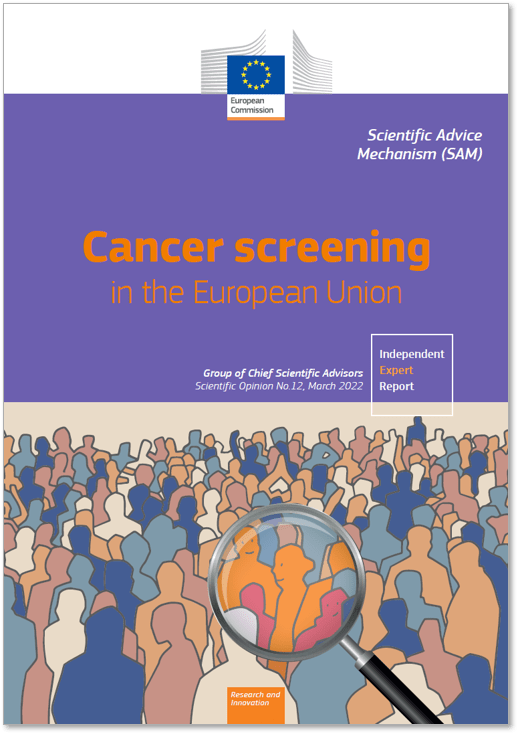The report provides independent scientific advice to inform EU-level policymaking on improving cancer screening across the Member States. It draws on the SAPEA (Science Advice for Policy by European Academies) evidence review and aims to guide the implementation of the EU Cancer Screening Scheme—part of Europe’s Beating Cancer Plan—to offer 90% of the eligible population access to screening for breast, cervical, and colorectal cancers by 2025.
Key Recommendations and Results
1. Enhance Current Screening Programmes (Breast, Cervical, Colorectal):
-
Screening must be citizen-centred, easily accessible (e.g. home-based tests, self-sampling), and embedded in a full pathway of care.
-
Participation should be improved through shared decision-making, informed choice, and tailored communication strategies.
-
Adoption of state-of-the-art technologies is recommended:
-
MRI for women with dense breasts.
-
HPV testing prioritized for cervical cancer screening.
-
FIT (faecal immunochemical testing) as the preferred test for colorectal cancer triage.
-
2. Extend Screening to Additional Cancers:
-
Lung cancer: Use low-dose CT scanning in high-risk groups (e.g., smokers); large trials have shown mortality reduction.
-
Prostate cancer: Combine PSA tests with MRI to reduce overdiagnosis and overtreatment.
-
Gastric cancer: Screen-and-treat for Helicobacter pylori only in high-incidence regions.
-
No current evidence supports population-based screening for ovarian or oesophageal cancers.
3. Leverage Technological Innovations:
-
Promote risk-based screening by using personalized risk profiles derived from factors like genetics, age, breast density, and family history.
-
Support the development of “living guidelines” that adapt rapidly to new scientific findings.
-
Prepare for liquid biopsy and blood-based multi-cancer detection methods that could offer less invasive and earlier diagnosis across multiple cancer types.
-
Establish biobanks to support biomarker research and standardized quality protocols across Member States.
Innovation and Technology Integration
-
Artificial Intelligence (AI) & Machine Learning (ML): Applied especially in imaging (e.g., breast tomosynthesis, lung CT), AI improves diagnostic accuracy and efficiency. AI-driven risk stratification tools also assist in prioritizing high-risk individuals for screening.
-
Genomic & Molecular Screening: Future readiness is required for blood-based tests detecting circulating tumor DNA, RNA, or protein biomarkers.
-
Decision Aids & Digital Tools: Electronic aids enhance informed participation, especially for populations with low health literacy.
Policy Implications
-
Cancer screening governance should be harmonized across the EU, with support for infrastructure, training, and quality assurance.
-
EU institutions should coordinate updated guidelines reflecting evolving scientific knowledge and promote equity across healthcare systems.
-
Stronger data collection and evaluation frameworks will enable Member States to monitor participation rates, outcomes, and effectiveness.

